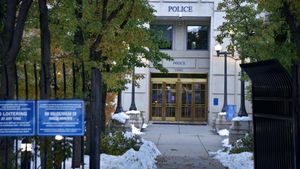The A-Level results day of 2024 has brought both exhilaration and anxiety for thousands of students across the UK. With students eagerly opening their result envelopes, many are refining plans for their next steps, whether it's heading to university, starting apprenticeships, or taking some time off.
Today, August 12, is the day students can finally discover if their hard work over the past two years will propel them to their dream universities. This summer, there was an overall increase in A Levels taken, with significant numbers of top grades achieved, even if the overall pass rate saw a slight dip.
It has been reported by the University and Colleges Admissions Service (UCAS) on results day, indicating about 425,680 UK applicants have secured university places, marking a 3% rise from last year. Out of these, 376,470 students were accepted at their first-choice universities, representing 82% of offers held by applicants.
When delving deep, England has noted acceptance rates climbing to 32.1% among 18-year-olds, which is also encouraging. Notably, this year's figures indicate 75.7% of applicants successfully made it to their first-choice universities, up from 71.6% last year.
Interestingly, Northern Ireland appears to be experiencing declines, with only 11,180 applicants securing places, which is part of a continuing downward trend. Across Wales, the numbers weren’t too optimistic either, with only 15,570 students being accepted, compared to the 16,330 of two years ago.
With international students, the statistics remain stable, reflecting over 50,000 students who've claimed admissions to UK universities. This includes 10,950 from China, albeit reflecting a slight drop compared to last year's numbers.
Subject-wise, there’s been noticeable growth particularly for courses like engineering, technology, and law which saw applicant boosts of 11% and 9% respectively. Interestingly, nursing fields yielded significant placements too, with 18,450 students securing spots, even though numbers still remain lower than during the pandemic peak.
Despite the overall positive passage to university, there’s concerning news related to disadvantaged backgrounds. A record number of students—around 27,600 from the lowest socio-economic backgrounds—accepted places this year, marking improvements yet also highlighting widening gaps between these and their more affluent peers.
While 22,640 disadvantaged 18-year-olds made it to university, this increase is shadowed by the fact regional gaps are becoming more pronounced. For example, London boasts 42.5% acceptance for university places among 18-year-olds, with stark contrasts compared to the North East's 25.3%.
This gap was reported to be 17.2 percentage points compared to previous years, emphasizing growing disparities. Such divides raise concerns, as efforts are pushed along by the government and UCAS alike, pledging necessary measures to bridge the gaps between the UK’s educational inequalities.
For students struggling to align grades with university expectations, the Clearing process presents alternatives. Students who fall short can explore the Clearing system, which connects them with available university places, allowing them to potentially reconsider their options.
While the sentiments around results day fluctuate, it’s imperative for students to grasp available support. Engaging with school career services alongside family can play pivotal roles during this high-pressure time.
A hallmark of the day was the heightened emotional states experienced by many students, with celebratory moments for numerous success stories. There were tears of joy, hugs exchanged, and narratives shared among peers, mapping their futures.
One standout story arose from Ormiston SWB Academy in Bilston, where students showcased remarkable results. Tegan Wood celebrated her double distinction* and has plans to study mental health nursing at the University of Birmingham, affirming dreams of working within secure units.
Meanwhile, Hollie Walker from the same academy earned excellent grades as well, leading her to pursue physical education and sports at Edge Hill University. The excitement dissipated through the halls, carrying stories of hard work paying off.
Colton Hills Community School reported 100% pass rates across multiple subjects, illustrating the strong academic endeavors by students. Similar achievements were echoed at The Royal School and Wednesfield Academy where top grades notched impressive university admissions.
At Tettenhall College, students celebrated improvements, with one pupil, Archie Wilkinson, lauded for his acceptance to Oxford for Experimental Psychology. Known for aspiring against all odds, he embodied the idea of following passions over pressures.
Principal Dan Mason from Ormiston SWB Academy celebrated the outcomes, stating the bright futures awaiting students who dedicated themselves throughout these challenging years. Notably, students from comprehensive schools also exhibited performance strides, highlighting progress among traditionally disadvantaged institutions.
On the contrary, challenges loom large over the national education sector, with critics pointing to the widening achievement gap owing to socio-economic backgrounds. Students from lower-income families continue facing hurdles compared to their wealthier counterparts, drawing focus on the inequality within educational opportunities.
Bridget Phillipson, the Education Secretary, acknowledged the widening gap and emphasized commitment across the education system. She remarked on the government's intent to dismantle barriers impeding equal opportunities, pushing positive educational reforms.
On the arts education front, there’s chatter within the community about declining entries on arts subjects. A worrying trend reveals arts entries have dropped significantly since 2010, with overall numbers hitting troubling lows, prompting many to advocate for better support and investment.
A surge of discussions on the results day also came from those interested about the future of their educational journeys. There were calls for students to explore their options amid changes to vocational pathways and to weigh course specifics carefully, ensuring choices align with personal and career aspirations.
With the stats rolling from every corner, celebration mingles with reflection today. The hard-fought achievements grant students pivotal openings but remain shadowed by the conversation around equity and accessibility for all in the future.
This year’s results underscore the bittersweet nature of progression; not only celebrating success but also acknowledging areas for growth. More than ever, it is clear—educational equality is needed to realize potential across the board.



